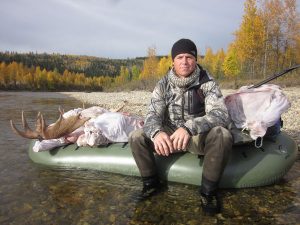
Twenty years ago, if I were asked if it would be possible to effectively hunt big game on Alaska’s rivers using a 15-pound raft, I would have laughed out loud and said, “No way!” The average raft weight in those days was 145 pounds. Today, it’s not only possible, it’s becoming the new trend with Alaska float hunters.
What has changed so much in 20 years to help shed so much raft weight, and what is driving thisnew methodology?
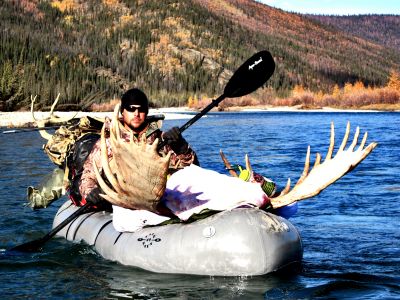
Actually, many things have changed. Inflatable technology has improved, hunting pressure is encouraging exploratory sprawl, the cost of air access has skyrocketed, hunters are becoming increasingly minimalistic, and Alaskans are determined and resourceful. All of which has led to the invention and use of the PR-49 (Packraft Alaskana).
Technology vs. Demand
To discuss technological evolution, we must remember that traditional inflatable rafts were originally designed for large groups with whitewater and recreational applications. Most raft manufacturers are based in the Lower 48, and they continue to build rafts for average American use—not for Alaska hunters. Traditional designs have larger footprints for stability, whitewater use, and easy maneuverability. This means that broad consumer demand produces rafts that are wide and long and have upturned bow and stern profiles for whitewater applications, which also require heavy, robust rowing frames with seats, coolers, and large oars—all of which make these designs inappropriate for remote, shallow stream character.
So, for decades Alaska boaters have been offered “traditional” watercraft that are heavy, bulky, and simply aren’t efficient with the use of small aircraft for logistical access.
In short, it’s been a profitable business model for over 40 years and Alaskans have made do, so why change? The answer is now becoming clear—it must change to suit the interests of Alaska float hunters. That means rafts, canoes, and now packrafts must be durable, lightweight, easily transported to the field, and capable of supporting heavy loads of meat, antlers, and gear. A demanding new standard has emerged.
It’s not so much that there has been a dramatic technological leap with fabric strength or construction, but that there is now a competitive availability of lightweight and durable fabrics between the U.S., Canada, and abroad. And access to overseas manufacturing has allowed raft designers like me a full spectrum of options to fill the demand for high performance watercraft for Alaska hunters at an affordable cost to consumers.
Hunting Pressure and Sprawl
I arrived on the Alaska hunting scene roughly 20 years ago, even wrote a book titled Float Hunting Alaska. Back then, hunters gathered “how-to” knowledge from books and magazines, but the “where-to” specifics were still closely guarded by most serious hunters. But, as the saying goes, “There’s many a slip twix a cup and the lip!” and more than a few honey holes were revealed to tens of dozens of eager groups looking to gain access to 70-inch bull moose or record-smashing caribou. Even still, with books and magazines being the most abundant sources of info gathering, word of these honey holes spread slowly by today’s standard. In those days, it took roughly 25 years of seasonal hunting pressure for rivers like the Stony, Mulchatna, Koyukuk, Innoko, and the 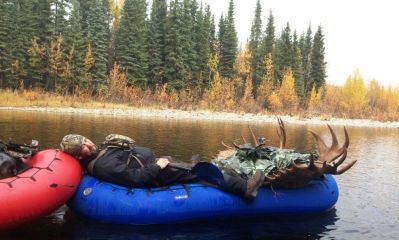 Iditarod to start showing signs of over-use. For example, during the 25-year period between 1970 and 1995 those areas averaged 75% success rates for unguided moose hunters. By 2005 (just ten years after the peak), the Koyukuk had gone to a Draw-Permit Area and the other rivers produced less than 30% success rates for moose. As of this writing (18 years after peak pressure), success rates are lower than 25% overall in many general harvest areas across the entire state. What changed? There are now simply more hunters using rivers to hunt big game, and access limitations concentrate hunting pressure. What’s more?
Iditarod to start showing signs of over-use. For example, during the 25-year period between 1970 and 1995 those areas averaged 75% success rates for unguided moose hunters. By 2005 (just ten years after the peak), the Koyukuk had gone to a Draw-Permit Area and the other rivers produced less than 30% success rates for moose. As of this writing (18 years after peak pressure), success rates are lower than 25% overall in many general harvest areas across the entire state. What changed? There are now simply more hunters using rivers to hunt big game, and access limitations concentrate hunting pressure. What’s more?
Enter the Ageof the Internet…Since 1995, hunters have freely shared where-to secrets with a click of the send button via internet forums, chat rooms, blogging sites, and other social media outlets. If you want to know where to hunt in Alaska, just Google it!
This says nothing for the volume of printed media and TV shows that exists today, touting “where-to” secrets for Alaska hunting. Call it good marketing, braggin’ rights or creating buzz, the result is the same: more hunters with more knowledge with budgets to hunt. All we need to know now is who to call for access and where to go for our trophies.
Today, the most popular rivers with the easiest logistics and intermediate skill-demand are ever so crowded. Human nature is to explore the easy-to-reach successful areas with standard raft designs until these locales either become overcrowded or stop producing success. When these effects bloom and doom, hunting pressure spills over into unexplored areas, and hunters are now venturing into tributaries off the beaten paths. That is where we are today; hunting pressure is on the rise and new borders are forming lines of traffic. But, until recently, these exploratory boundaries were limited by access options and the burden of using heavy, oversized raft equipment.Now raft equipment is rapidly being reshaped to suit these adventure seekers.
Air Access is Spendy
Over the years I’ve spent an exorbitant amount of cash on remote river access, so I consider myself fortunate, financially drained and well-versed on this topic. The cost of small aircraft operations in Alaska is expensive, period. Between the rising costs of fuel and insurance, as well as higher-than-ever demand, hunters are paying a premium for bush logistics.
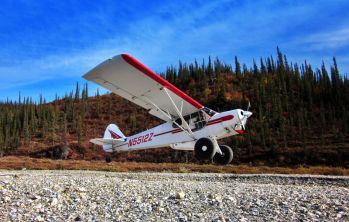
Hunters are now eager to find less expensive access options into remote swaths of terrain for hunting and fishing opportunities. Savvy hunters have learned there are virtually two ways to lower the cost of access: 1) Reduce the size of their group and limit personal gear weight and bulk to minimize the number of flights and size of aircraft required; 2) Become packrafters to enable them to hike farther and fly less.
Packrafts are changing the way we engage remote access. The use of packrafts provides a smaller gear footprint and force us to travel with less personal equipment, which reduces the amount we spend on air access. Today, the pile of gear for two hunters is lighter and less bulky than it was 20 years ago. This fact allows hunters to charter smaller, less expensive aircraft to remote areas. After a few flights with less gear weight and bulk, the savings adds up to cover the cost of their new packraft.
The Minimalistic Hunter
Gear evolution is a trend worth reporting. Companies are making lighter and more effective equipment and clothing, which lends the advantage of weight savings. Twenty years ago the average hunter transported 125-150-lbs of personal gear and food per person to the field, and that does not include the weight and bulk of an old-school raft (125- to 200 pounds); but today those weights have been reduced by 50% for food and gear and 90% for smaller watercraft.
From tasty, high caloric dehydrated meals to merino wool garments to synthetic fabric technology to smaller, high performance packrafts, the minimalistic hunter is a lean, mean hunting machine. My average packing list with 10-days of food, clothing, hunting equipment, and watercraft for an epic backcountry river adventure weighs 100 pounds total (70% total weight reduction since 1993).
Resourceful Alaskans
What do all Alaska residents have in common, besides Vitamin D deficiency and frost nipped body parts? Resourcefulness!
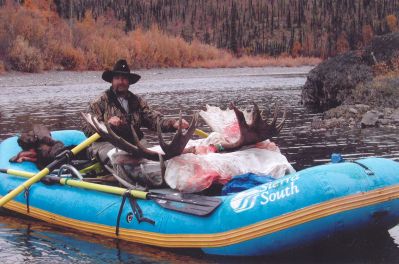
If there’s a problem that has a fix, set an Alaskan to the task and watch the problem dissolve. Whether that task is squeezing blood from a turnip and turning that pulp into gold, or designing a 15-pound raft that holds a hunter, his gear, and 400 pounds of meat and bone, it shall be done!
Alas, the PR-49 (Packraft Alaskana) is born.
The PackRaft Alaskana (PR-49) is a 15-pound packraft designed specifically for Alaskan adventures. This 9-ft packraft has an impressive 850-lb load capacity and is constructed of tough PVC material using 420-denier side tubes and 840-denier floor thickness, with plenty of lashing points and strong handles for ergonomic dragging and lining around hazards. Special design features include a revolutionary seat and cargo sling that provides high performance control and effective load displacement. Each raft comes equipped with a mesh seat and cargo sling, double-action air pump, a robust repair
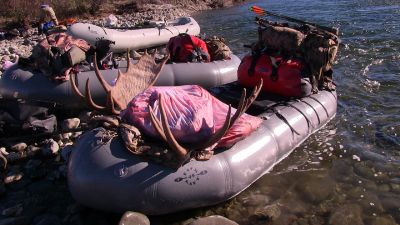
kit with extra material for extensive repairs, a 240-cm four-piece Aqua-Bound kayak paddle, and a PVC carry bag for easy transport to the field. Designed by Alaska Resident and Float Hunting guru, Larry Bartlett, this packraft provides an extreme access option for serious hunters and anglers, and this boat is ideal for wilderness streams with character ratings of Class I-III. Customers can expect extremely shallow draft with moderate loads.
Check out the Fish Alaska video page to see this boat in field action!
